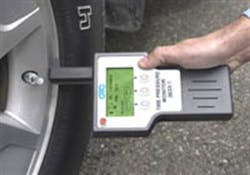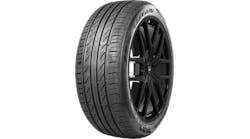TIRE PRESSURE MONITORING SYSTEMS: Protecting drivers from themselves
A tire pressure monitoring system, also referred to as TPMS, is relatively basic in terms of the number of involved components. The pressure sensor transmitters (one transmitter mounted inside each wheel) monitor inflation data and send a radio signal to the system's antenna and receiver, which then sends a digital signal to an ECU. Note that some vehicles are equipped with one central antenna, while others feature individual antennas in the wheel wells at each corner.
A direct tire pressure monitoring system -- one in which a dedicated system exists that monitors actual tire inflation pressure -- is generally calibrated to alert the driver when one or more tires have lost at least 20% to 25% of the programmed/recommended inflation pressure.
In most instances, if a "fault" signal is processed by the ECU, the in-dash tire pressure warning light will illuminate, while if a tire pressure problem is indicated, the warning light will illuminate constantly. If the light blinks, as it does in many newer OEM systems, it indicates a system fault that must then be diagnosed with the proper diagnostic tool.
It's important to note that whenever sensors are moved to new locations (during wheel rotation, etc.), the individual sensors may need to be re-programmed or re-set in order to maintain correct location information for the system ECU. Otherwise, each sensor may transmit correct inflation data, but the ECU will then assign the pressure data to the wrong corner(s) of the vehicle.
For example, if a vehicle is equipped with dash information that identifies each specific wheel location, you may see a warning that the left front tire is low, when, in fact, the low pressure problem may be found at the right rear (because the wheels were rotated and the sensors were never re-set).
That is why it is so important that you get your technicians TPMS training. (We highly recommend they use this story as a primer.) The Tire Industry Association offers a certified TPMS training program; others also offer training, including tire manufacturers and auto parts chains such as NAPA.
[PAGEBREAK]
TPMS components
Two basic "styles" of TPMS sensor/transmitters are available: banded and stemmed. (The correct OEM term for the sensor is wheel mounted sensor.)
Banded sensors are affixed to the inside of the wheel using both a positioning adhesive (peel off) and a band clamp. Stemmed sensors feature the valve stem as an integral part of the sensor. The sensor mounts via the wheel's valve hole and is secured with a mounting nut.
Depending on the maker's design, these wireless pressure sensors transmit their data to an ECU using either AM or FM signals, usually in the 125 kilohertz range.
Five primary sources for OEM tire pressure monitoring systems include Schrader Electronics Ltd., Beru AG, Pacific Ltd., Siemens AG, TRW Automotive, etc. Schrader systems are found on Ford, Chrysler, GM and Nissan/Infiniti applications. Pacific systems are found on certain Toyota (including Lexus) and Honda vehicles. Beru systems are used on Mercedes, Porsche, BMW, Audi/VW and Land Rover models.
Since the OE transmitters are the stem type, the wheels are designed to accommodate these units (the valve stem hole area is configured for these transmitters). Some aftermarket wheels do not allow the addition of the stem-type transmitter, which makes them suitable for a band (strap-on) type.
The vast majority of OE tire pressure monitoring systems are stem-mounted as opposed to band-mounted. The primary reason involves diagnostic capabilities. If the sensor is band-mounted and deeper inside the wheel, it's more difficult for the signal to pass to the diagnostic tool, whether the system uses an RF signal or a magnetic signal.
Stem-type sensors are light, weighing in the neighborhood of about an ounce, so this won't be a problem regarding wheel balance compensation.
Most direct type pressure sensors are powered by a lithium battery with an expected lifespan of seven to 10 years. Many of them are designed to operate only during or after a 20 mph-plus driving experience. When the vehicle is parked, the sensors are usually designed to transmit pressure only once per hour or so, in order to preserve battery life.
[PAGEBREAK]
Who needs a TPMS?
Are tire pressure monitoring systems really necessary? Some might say that these systems are a waste of money, arguing that if people would simply check their tire pressures on a regular basis, there would be no need for an on-board monitoring system. But, therein lies the rub. Most people don't bother checking inflation pressures, at least not as often as they should.
Aside from protecting people from their own ignorance, tire pressure monitoring systems do make sense for a number of reasons.
1. They provide safety. Even for those who recognize the importance of tire pressure and routinely perform a manual check, it's nice to be alerted to a drop in pressure before the tire fails. It doesn't matter whether the drop results from a puncture, faulty valve or chuckhole tear.
2. They protect run-flat tires. Another example of the need for a TPMS lies in the design of run-flat/zero-pressure tires. Many of the run-flat tires on the market are constructed so superbly that a drop in pressure may not be discernable to the driver. So it's vital to have a system in place that alerts the driver of a low pressure problem in an effort to prevent tire damage and avoid a traffic mishap.
Regardless of personal opinions on the matter, we really don't have a choice. After Aug. 31, 2007, all new model four-wheeled vehicles weighing 10,000 pounds or less must be equipped with tire pressure monitoring systems. This means that the aftermarket service industry must be able to handle these systems properly and diagnose system problems.
Indirect systems
As a relatively inexpensive method of altering the driver to a low tire pressure situation, some OEM vehicles obtain this information not through a dedicated direct tire pressure monitoring system, but rather by using information already monitored by the anti-lock braking system. This is referred to as an indirect TPMS.
A "low" tire will rotate at a different rate than properly inflated tires (due to a difference in rolling tire diameter); this difference in wheel rotation is sensed by the ABS. A signal is then sent to alert the driver via a warning light. It's then up to the driver to check all four tires to determine which is under-inflated.
[PAGEBREAK]
This approach has its problems. Faulty alerts can easily result if the wheels slip on an icy road, or if inside and outside wheels rotate at different speeds during sharp turns, because ABS monitoring interprets a difference in rotation as a low pressure condition. In addition, if all four tires are equally under-inflated, the ABS won't trigger the pressure warning, since all wheels are rotating at the same speed.
In general, indirect tire pressure monitoring systems are designed to illuminate the warning light when a single tire's recommended inflation pressure has dropped by about 30%.
Aftermarket systems
We're aware of only three aftermarket tire pressure monitoring systems which are available for retrofitting. These include SmarTire, Schrader and Doran.
The SmarTire second generation four-wheel system kit includes four band-mounted wheel-mount pressure sensors and a receiver/display unit that is mounted to any convenient interior location. The wireless pressure sensors weigh less than 1.5 ounces and, according to SmarTire, are accurate to 1.5 psi.
Mounting straps that accommodate 13-inch to 20-inch diameter wheels are used to band the sensor to the wheel's well area. The sensors are equipped with motion detectors that turn off the sensors when the vehicle is parked in order to prolong the life of the lithium batteries (SmarTire estimates battery life at five years of normal use). No programming is required, and the receiver is powered by a simple 12-volt plug-in.
The basic receiver display identifies each tire by a color-coded light. Each sensor is also color coded, as is each tire-valve-mounted washer. This makes identifying specific wheels easy. If tire pressure drops to 22 psi, a red LED on the display will illuminate above the individual color-coded indicators. If air pressure drops to 18 psi, a second-level warning will activate an audible alarm, and the LED will flash red.
Schrader offers its Smart Valve RF tire pressure monitoring system, Generation II. This is a direct system similar in nature to OE systems. Individual stem-type sensors are mounted to each wheel. The sensors transmit data to individual wheel-well-mounted detectors, which, in turn, send signals to the centrally-mounted receiver.
Sensor/transmitter pressure measurements will accommodate pressures up to 150 psi, with 0.2 resolution and 2% accuracy. RF frequencies are offered at 315 Mhz, 433.92 Mhz and 868 Mhz.
Doran offers its PressurePro systems for a wide variety of applications, including passenger vehicles, light- to heavy-duty trucks, motor homes, fifth-wheel trailers and tag trailers. Kits basically consist of a monitor that is installed in the dash area and runs on 12 volts. Individual sensors mount directly to each existing wheel valve (screw the sensor to the valve, replacing the original stem cap).
According to Doran, the system will sound an audible alarm if any tire loses more than 12% of its programmed pressure. A simple programming procedure is outlined with the kit's instructions.
[PAGEBREAK]
Tools of the trade
In order to service any direct TPMS, a testing tool is absolutely required. At the OE level, these calibration/re-setting/diagnostic tools range from hefty hand-held units to large stationary pieces of equipment. For aftermarket use, easy-to-use hand-held testers are readily available.
You don't have a choice, by the way. If you plan to stay in the tire and wheel business, you must be able to reset and troubleshoot tire pressure monitoring systems. For that you need a tester.
A TPMS diagnostic tool has two common uses: re-setting the system and pre-testing the system's operation, which helps determine if a system fault exists. You should perform a system re-set whenever wheels are rotated, or whenever sensors are moved from their original locations on the vehicle. Re-setting accounts for about 75% of the tool's use.
According to SPX/OTC Product Manager Rob Kochie, a typical scenario involving the need to pre-test is as follows: The owner of a 2005 Corvette (equipped with a TPMS) pulls into your shop in need of new tires. Following the tire service (dismounting, mounting, balancing and installation), the tire pressure warning light is illuminated.
The diagnostic tool can be employed to determine the fault, which might be traced to a specific sensor that was damaged during dismounting or mounting.
The confusing aspect of tire pressure monitoring systems today is a result of the proliferation of system designs and diagnostic capabilities. Some systems are more adjustable than others. Some systems require re-setting if battery power is interrupted, while this is not a factor in other systems. Some systems collect data relative to any tire, while others identify specific tire locations.
Procedures for re-setting also vary among vehicle makes/models/years. Full-size spares (where applicable) are monitored while spares on some models are not.
In all, there are about 40 to 50 different testing and re-setting protocols in use, which poses a challenge for makers of testing and diagnostic tools. Some service tools are make/model/year-specific, while others are designed to communicate with a variety, if not all, of the various tire pressure monitoring systems.
Here's one service example: When performing a re-set on a 2005 Corvette, the ignition key is turned to the ACC mode, while two buttons on the remote key fob are pressed and held. Following instructions provided by the testing tool, each sensor will re-set and will confirm the new "learn" by beeping the horn or flashing the lights.
We simply don't have room here to describe each make/model/year initialization or re-setting procedures. For any given procedure, the steps will be outlined in the vehicle's service manual, or can be obtained through Mitchell1's available data, or by following the steps provided with a TPMS service tool.
Remember that any direct system's individual wheel sensor/transmitter will feature an ID code. Whenever replacing a sensor (or tire pressure monitoring system ECU), you'll need to record the sensor ID code. Depending on the brand of the sensor, this will appear somewhere on the main body of the sensor.
[PAGEBREAK]
On the market
The OTC Tire Pressure Monitor (P/N 3833) is a hand-held device that, according to OTC, is a complete and universal monitor for all OEM TPMS versions, capable of handling all OEM protocols. Once the vehicle's make, model and year have been entered, the user is able to reset or diagnose any TPMS. If a reset procedure is selected, the monitor directs the user to the correct section of the kit's manual. The procedure manual is offered in both printed (P/N 383-02) and CD (P/N 3833-03) versions.
If diagnostics is selected, data for troubleshooting the TPMS can be obtained by using the monitor to activate the sensors and inspect the transmitted data. The monitor displays the sensor data, such as ID and pressure, depending on system type. The monitor also maintains "last vehicle use" history, and can be updated via a serial cable to a PC to keep up with changing vehicle requirements.
The monitor is powered by three C batteries. A very nice feature of this monitor lies in its big, easy-to-read display screen that provides readable data as opposed to only flashing LED lights.
Bartec manufactures tools for use both at the OEM factory and dealership levels, offering an array of hand-held OEM-specific tools.
Two models targeted specifically at the aftermarket are the DBL3 and the DEG.
The DBL3 is an entry-level sensor "trigger" and test tool, and retails at $429. The DEG is a heavy-duty trigger, test and diagnostic tool that features a large display. This retails for $1,999.
According to Scot Holloway, general manager of Bartec USA, a quality service tool will be able to initiate the sensor, informing you of the sensor status (good/faulty). The TPMS wheel sensor features a small 10-year battery that maintains an internal "clock," recording a packet of data including the sensor ID number, temperature and pressure. A "good" tool will decode that message to determine sensor status.
Holloway noted that with some lesser/very inexpensive tools, the sensor "learn" procedure may require 20 minutes or more, requiring a driving loop. A higher-end tool can force the sensor to transmit data, requiring only one and a half minute or so in the service bay.
Bartec offers three versions of diagnostic tools for both the aftermarket and the new-car dealer. Prices range from $299-$399 for a universal tool that will work for any sensor which operates at 125 kilohertz. A higher-end tool that features a display screen is available for $499, which is able to identify and alter the sensor mode (some sensors feature multiple modes, including ship mode, test mode, park mode and normal mode). The tool must be able to identify the specific mode to avoid mis-diagnosing a good sensor as faulty.
Available from Spectrum Composites, the T.I.P.S. tool (Tire Inflation Positioning Switch) is a universal LED sensor re-setting tool designed only to re-set/initiate "all known tire sensors available in the marketplace today." In addition, a number of tire manufactures are heavily involved in producing tire pressure monitoring systems. EnTire Solutions LLC is a joint venture between Michelin North America Inc. and TRW Automotive. The company produces direct systems for Honda, Hyundai, Kia, General Motors and Fiat vehicles.
Yokohama Rubber Co. has developed the Precision Tire Behavior Monitoring System. It features a sensor that not only checks air pressure, but also observes tire behavior and road surface conditions. Yokohama also has developed the AIR Watch TPMS, which is designed for passenger cars.
[PAGEBREAK]
Nokian Tyres plc's RoadSnoop Pressure Watch is designed to measure tire pressure, temperature and speed. It is available to the OE market and automotive aftermarket.
Sumitomo Rubber Industries supplies its indirect tire deflation warning system software to Robert Bosch GmbH. Goodyear Tire & Rubber Co. and Siemens VDO Automotive AG have jointly created the Tire IQ tire pressure monitoring system. Pirelli & Cie SpA unveiled its X-Pressure tire pressure monitoring system last year. It consists of a sensor that fits to a tire valve and communicates pressure drops four different ways. Pirelli also has been testing its Safety Wheel System (SWS) on an SUV wheel. The SWS can be used with both run-flat and conventional tires.
Without a tester tool! How to initialize indirect systems
As an example of initializing on an indirect system, where a tester tool is not necessarily required, we'll cite a late model Toyota.
First, adjust each tire's inflation pressure to the recommended pressure. With the vehicle stopped, turn the ignition switch to the "on" position.
Press and hold the tire pressure warning reset switch until the tire pressure warning light blinks three times at one second intervals (on a 2006 model, this switch is located under the left side of the dash). Drive the vehicle at 19 mph or more in order to complete the initialization of the skid control ECU. This takes about one half to a full hour.
If the tire pressure warning light blinks at 0.25-second intervals while the vehicle is being driven, the initialization may have failed. In this case, perform the initialization again. After initialization is completed, the skid control ECU monitors tire pressure by using the ABS/traction control wheel speed sensors.
Ready, re-set, go!
Re-setting a tire pressure monitoring system (TPMS) is required if any of a number of procedures are performed, including the following: * tire pressure correction(s).
* tire/wheel rotation.
* tire/wheel replacement.
* TPMS sensor replacement.
* receiver antenna replacement.
* TPMS control unit replacement.
* in some cases, loss of vehicle battery power.
Each TPMS sensor must experience a "learn" regarding vehicle location, which is handled with the use of the proper diagnostic/service tool.
[PAGEBREAK]
DISMOUNTING & MOUNTING PRECAUTIONS REGARDING TPMS
1. Average mounting grommet life on most TPMS sensors is about five years, at which time the grommet must be replaced. To avoid any confusion, replace the grommets whenever the tire/wheel is serviced. However, because these grommet kits are not readily available -- and are expensive -- the Tire Industry Association suggests an alternative service option. "We say if you remove the sensor from the rim, you must replace the grommet," says Kevin Rohlwing, senior vice president of education and technical service. "But if the customer chooses not to replace the grommets, the assembly can be serviced with the sensor in place."
2. Always follow the vehicle service manual's tightening specification for TPMS sensor nut torque. Not all stem-type sensors require the same torque value!
3. Do not attempt to install an OEM stem-type TPMS sensor onto any wheel that is not specifically designed for this application. This includes steel wheels, and any alloy aftermarket wheel that is not designed for the sensor.
4. Only replace valve stem cores with the original or an original replacement. Using a core that is not nickel plated can lead to corrosion and pressure loss (valve stem sensors are often made of aluminum with a special coating, and require a nickel-coated core to prevent corrosion).
5. Before breaking the tire bead and in order to avoid damaging a stem-type TPMS sensor during dismounting, fully deflate the tire, remove the mounting nut and gently push the sensor into the tire (the tire/wheel should be in a vertical position, with the sensor positioned at the 6 o'clock position during drop-in to avoid the sensor hitting the wheel). Once the outer bead is unseated, reach into the tire and retrieve the sensor to prevent further potential damage.
6. To prevent moisture and dirt contamination, always reinstall the original type valve cap, which will feature a small sealing O-ring.
7. When re-installing a stem-type TPMS sensor, secure the valve to prevent rotation during nut tightening. Once tightened, the gap between each side of the sensor body and the wheel surface should be equal.
[PAGEBREAK]
8. Never allow the tire machine's mounting head to touch the sensor.
9 Even if no telltale stem-type valve is visible on the outside of the wheel, never assume that no TPMS sensor is present. Always ask the customer if a tire pressure monitoring system has been installed. An aftermarket band-mounted sensor, for instance, will not be visible until the first tire bead has been unseated, and then only if the technician bothers to look for the sensor. If a tire iron tool is used as an assist, the tool's tip may smash into the sensor.
Tip: If a color-coded washer is visible on the outer stem area, this is a clue that a band-mounted sensor is in place.
10. Once the stem-type TPMS sensor is remounted to the wheel, position the wheel/tire on the tire machine so that the sensor is located about 270 degrees from the mounting head before attempting to begin pressing the tire bead onto the rim. This will minimize risk of damage. For more information on precautions to take when mounting and demounting custom wheels, check out previous-year Performance Handbooks on this Web site.
Tire pressure monitoring systems and equipment
OE
Schrader Electronics Ltd., Northern Ireland, U.K., +44 (0) 28 9446 1300, www.schraderelectronics.com. Produces systems for GM, Infiniti, Jeep, Lincoln, Mercury, Mitsubishi, Nissan, Saab, Suzuki.
Siemens AG, Munich, Germany, +49 89 636-00, www.siemens.com.
Produces systems for Chrysler/Dodge, Jeep, Mazda.
Beru AG, Ludwigsburg, Germany, +49 7141 132-0, www.beru.com. Produces systems for Mercedes, Porsche, BMW, Audi/VW, Land Rover.
Pacific Ltd., Ogaki, Gifu, Japan, (0584) 91-1111, www.pacific-ind.co. Produces systems for Lexus/Toyota.
[PAGEBREAK]
TRW Automotive, Wixom, MI, (248) 863-2400, www.trw.com. Produces systems for Acura, Honda.
Advantage PressurePro LLC, Harrisonville, Mo., (816) 887-3505,
www.advantagepressurepro.com. Produces the PressurePro TPMS for automotive aftermarket.
AFTERMARKET
Schrader Electronics Ltd., Northern Ireland, U.K., +44 (0) 28 9446 1300, www.schraderelectronics.com
Doran Manufacturing LLC, Cincinnati, Ohio, (866) 816-7233, www.doranmfg.com
SmarTire Systems Inc., Richmond, British Columbia, Canada, (888) 982-3001, www.smartire.com or Hawk Associates Inc.,
Key Largo, Fla., (305) 451-1888, www.hawkassociates.com
Advantage PressurePro LLC, Harrisonville, Mo.,(816) 887-3505, www.advantagepressurepro.com
TireStamp Inc., Kanata, Ontario, Canada, (613) 271-2928 or (877) 878-4445, www.tirestamp.com. Produces TireVigil sensors/servers for passenger car fleets.
INFORMATION SOURCES
Bartec Auto ID Ltd. (tools and information), Sterling Heights, Mich., (586) 685-1300 (866) 407-TPMS, www.bartecusa.com
Mitchell1, Tire Pressure Monitoring Systems Guide (information in booklet form or software), (858) 391-5000 or (888) 724-6742, www.mitchell1.com
SPX/OTC (tools and information), Owatonna, Minn., (507) 455-7339 or (800) 533-5338, www.otctools.com
Spectrum Composites Inc./T.I.P.S., (Tire Inflation Positioning Switch tool), Auburn Hills, Mich., (800) 359-9855, www.tipstool.com




